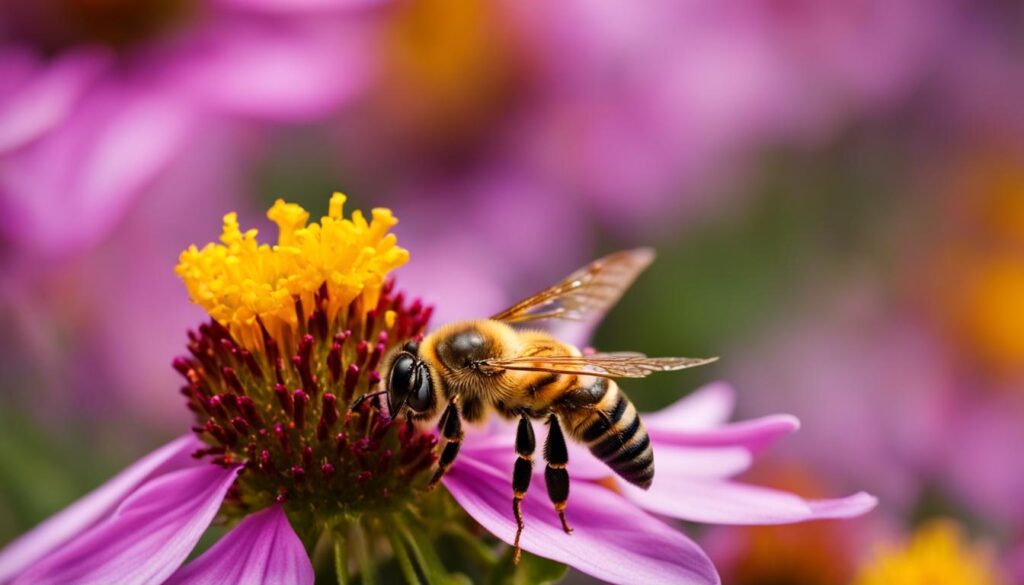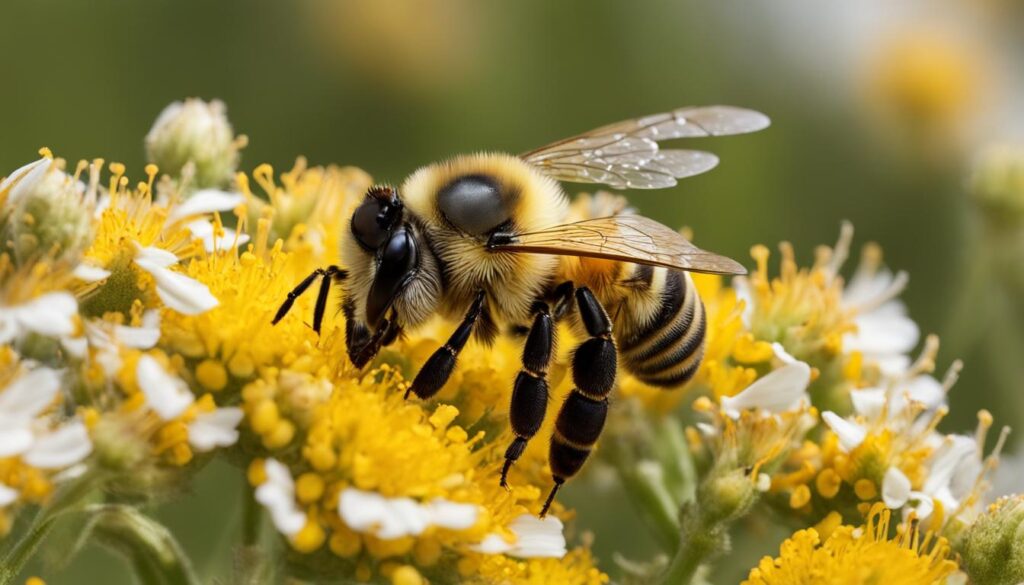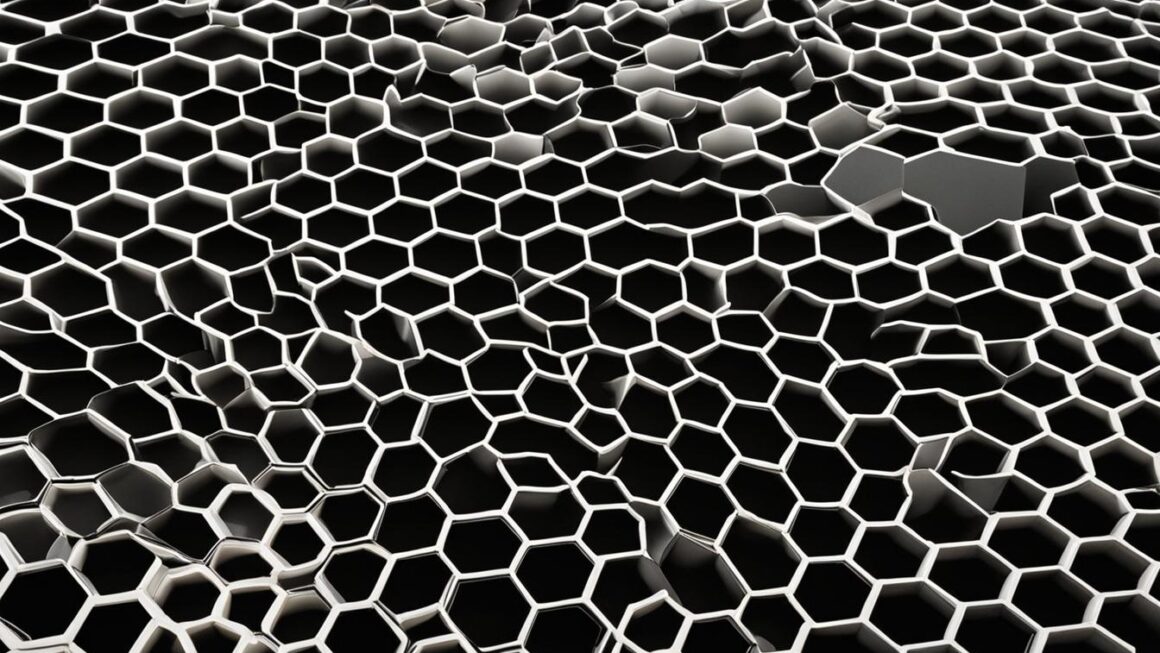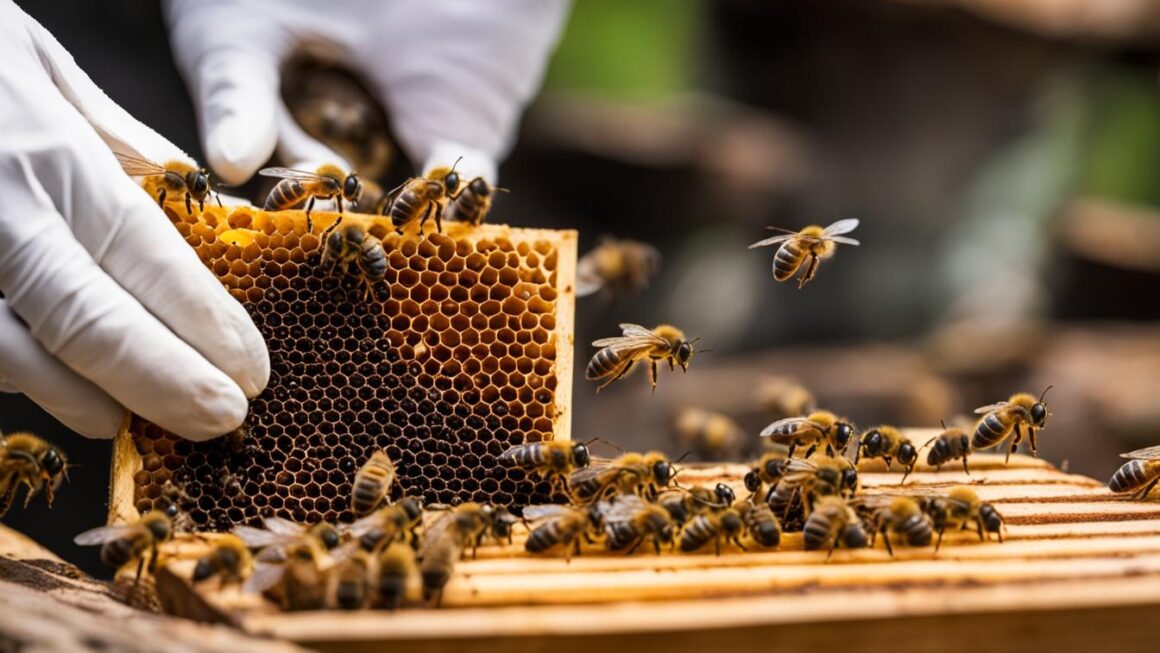Bees are remarkable creatures that play a crucial role in pollination and the production of honey. But have you ever wondered how much pollen a bee can carry? In this article, we will explore the bee’s pollen-carrying capacity and the importance of pollen collection for honey bees.
Key Takeaways:
- Honey bees can carry a pollen load weighing about 35% of their body weight on specialized structures called pollen baskets.
- A typical-size honey bee colony collects about 57 kg of pollen per year, storing it as bee bread.
- Pollen is vital for honey bees’ growth, development, and overall colony health.
- The protein content in pollen varies among different sources and is crucial for honey bee nutrition.
- Understanding pollen collection is important for beekeepers to support honey bee colonies and contribute to pollination efforts worldwide.
The Importance of Pollen to Honey Bees
Pollen plays a crucial role in the growth and development of honey bees. Not only does it provide essential protein, but it also contributes to the production of brood and the development of young bees. Honey bees have a unique foraging behavior when it comes to pollen collection. Instead of selecting pollen based on its nutritive value, they rely on odor and physical configuration. This allows them to collect pollen from a variety of floral sources, ensuring a diverse range of nutrients for the colony.
Nurse bees, responsible for feeding young larvae, consume most of the pollen collected. They use it to secrete royal jelly, a nutritious substance vital for the growth of developing bees. Pollen-carrying bees typically focus on collecting either pollen or nectar on each foraging trip. They often forage on one type of flower during a single trip, aiding in cross-pollination between plants.
The collection and transportation of pollen by honey bees have significant implications for the survival of both the bees and the plants they visit. Pollen collection ensures the availability of protein-rich resources for the colony, promoting the longevity and productivity of worker bees. Additionally, the act of pollination by bees contributes to the reproduction of various plant species, including many agricultural crops. Therefore, understanding and supporting the importance of pollen to honey bees is crucial for both beekeepers and environmental conservation efforts.
The Role of Honey Bees in Pollination
Pollen collection is an integral part of the pollination process carried out by honey bees. When bees visit flowers to collect nectar, they inadvertently pick up pollen grains on their bodies. As they move from flower to flower, pollen is transferred, allowing for cross-pollination and fertilization. This process is essential for the reproduction of many plant species, including those that are economically valuable.
Through their foraging behavior and unique ability to carry and transport pollen, honey bees contribute to the biodiversity of ecosystems and play a critical role in crop production. Approximately 35% of the world’s crop production relies on pollinators like honey bees. By aiding in the pollination of crops, honey bees ensure that fruit and seed production is successful, ultimately contributing to food security and global agricultural sustainability.
Honey Bee Pollen Collection: A Fascinating Process
Honey bees have evolved a remarkable method for collecting and transporting pollen efficiently. They have specialized structures on their hind legs called pollen baskets or corbiculae. These structures are fringed with long, curved hairs that allow the pollen to adhere and become embedded, ensuring its secure transportation back to the hive.
The pollen collection process involves bees brushing and squeezing the collected pollen onto their hind legs, gradually forming distinct pollen pellets. The bees then use their middle legs to transfer the pollen pellets from the brush to the pollen baskets. This process continues until the pollen load reaches a weight of around 35% of the bee’s body weight.
| Pollen Collection Process | Description |
|---|---|
| Brushing | Bees brush pollen with their specialized hairs and legs, gathering the loose grains. |
| Squeezing | The bees compress the collected pollen with their mouthparts, shaping it into compact pellets. |
| Transfer | The pollen pellets are transferred from the brush to the pollen baskets on the hind legs. |
The specialized pollen baskets enable honey bees to collect and transport pollen from various floral sources, even when the size and shape of the pollen grains differ. This efficient pollen collection process not only supports the nutritional needs of the colony but also contributes to the pollination of numerous plant species, making honey bees essential pollinators in both natural and agricultural ecosystems.
Production and Composition of Pollen
Pollen plays a crucial role in the life of honey bees and their colonies. It is produced by the stamen of flowers, the male reproductive organs. Different plant species produce varying quantities and qualities of pollen, with some plants producing abundant amounts while others produce smaller but high-quality pollen. The composition of pollen can vary among different pollens, with variations in water content, crude protein, carbohydrates, lipids, ash, and unknown components.
Pollen composition analysis is a complex process, and only a few types of pollens have been well-investigated. The protein content of pollen is particularly important for honey bee nutrition, as it provides the necessary nutrients for their growth and development. However, the significance of other trace nutrients in pollen is not well understood.
Understanding the production and composition of pollen is not only important for honey bee health but also for the pollination process. Pollen production and composition directly influence the overall health and productivity of honey bee colonies, as well as their role in the pollination of various plant species.
Pollen Composition Comparison Table
| Pollen Source | Protein Content (%) | Carbohydrate Content (%) | Lipid Content (%) |
|---|---|---|---|
| Canola | 22-33 | 24-30 | 13-31 |
| Almond | 24-30 | 14-18 | 4-5 |
| Raspberry/Blackberry | 8-12 | 21-26 | 2-4 |
| Sunflower | 15-29 | 21-30 | 2-5 |
| Pine | 4-6 | 32-49 | 3-8 |
This table compares the protein, carbohydrate, and lipid contents of pollen from different plant sources. Canola and almond pollens have relatively high protein contents, while raspberry/blackberry and sunflower pollens have lower protein levels. Pine trees produce pollen with low protein content. This variation in pollen composition highlights the diversity of nutrient sources that honey bees can access and utilize for their nutritional needs.
Pollen Collection Process
Pollen collection is a crucial aspect of the foraging behavior of honey bees. They collect pollen from various floral sources and play a vital role in the pollination process. Honey bees have developed a unique method to efficiently collect and transport pollen back to their hive.
Bees use their hind legs, which are equipped with specialized structures called pollen baskets or corbiculae, to carry the pollen. The pollen is sticky, allowing it to adhere to the bees’ legs, and the corbiculae help secure the pollen during transportation. This enables honey bees to collect pollen particles of different shapes and sizes and ensure the transfer of pollen between plants, contributing to cross-pollination.
The pollen collection process involves honey bees foraging on one kind of flower during a single trip to maximize efficiency and ensure effective pollination. Bees can collect pollen even from plants that do not provide nectar, expanding the range of plants that can benefit from their pollination services. By collecting pollen from a diverse range of floral sources, honey bees ensure they have access to a variety of nutrients to meet their nutritional needs.
Table: Pollen Collection Process
| Pollen Collection Process | Description |
|---|---|
| Pollen Baskets | Honey bees use specialized structures called pollen baskets or corbiculae on their hind legs to carry pollen. These baskets are fringed with long, curved hairs that allow the pollen to adhere and become embedded, providing secure adhesion during transportation. |
| Sticky Pollen | Pollen particles are sticky, enabling them to adhere to the bees’ legs and bodies. This stickiness ensures that the pollen remains in place during flight and transportation between flowers. |
| Efficient Foraging | Honey bees forage on one type of flower during a single trip to maximize efficiency. This behavior ensures that they carry and transfer pollen from one plant species to another, enhancing cross-pollination and increasing genetic diversity among plants. |
The efficient pollen collection process of honey bees contributes to the pollination process and the reproduction of various plant species. Their ability to collect and transport pollen long distances has significant implications for biodiversity and crop production.
Pollen Quantity and Storage
One of the fascinating aspects of honey bees is their ability to carry a significant amount of pollen. A single bee can carry a pollen load that weighs about 35% of its body weight. This impressive capacity allows honey bees to collect ample amounts of pollen during their foraging trips.
On average, a colony consisting of approximately 20,000 bees can collect about 57 kg of pollen per year. This pollen is brought back to the hive and stored in cells as bee bread. The bee bread serves as a nutritious food source for the colony, providing essential proteins, fats, minerals, and vitamins.
To ensure the longevity and health of the colony, honey bees store the pollen at the perimeter of the brood nest. This storage location allows easy access to the pollen when needed. When stored during the brood-rearing season, the pollen remains viable for only a few days. However, during winter, when there is a surplus of pollen, it can be stored for a longer period.
| Pollen Quantity and Storage | |
|---|---|
| Maximum Pollen Load Carried by a Single Bee | About 35% of its body weight |
| Pollen Collected per Year by a Colony | About 57 kg |
| Pollen Storage | Stored at the perimeter of the brood nest |
Overall, the ability of honey bees to carry and store large quantities of pollen is crucial for the survival and success of the colony. It ensures a steady supply of food for the bees and contributes to the overall health and productivity of the hive.
“The pollen basket on the bee’s hind leg allows them to carry a significant load of pollen back to the hive. This efficient storage method ensures a steady supply of nutrition for the colony.”
Nutritional Importance of Pollen
Pollen plays a vital role in the growth and development of honey bees. Immature bees require a substantial amount of pollen to meet their protein needs. It is estimated that a single worker larva needs approximately 124-145 mg of pollen, containing about 30 mg of protein. Pollen with protein levels ranging from 20-25% crude protein is highly valuable for honey bee colonies as it readily fulfills their protein requirements. A diet rich in high-protein pollen promotes the longevity of worker bees and contributes to the overall health of the colony.
“A single worker larva needs approximately 124-145 mg of pollen, containing about 30 mg of protein.”
While protein content is the most studied component of pollen, the significance of other trace nutrients to honey bees is not yet fully understood. However, it is clear that a well-rounded diet of high-quality pollen is essential for brood rearing and colony maintenance. Pollen low in protein content can negatively impact brood production and overall colony health. Thus, ensuring a diverse range of pollen sources with adequate protein content is crucial for beekeepers to support honey bee colonies and promote their well-being.

Table: Protein Levels in Different Pollen Samples
| Pollen Source | Protein Content (%) |
|---|---|
| Canola | 25 |
| Almond | 24 |
| Raspberry/Blackberry | 18 |
| Sunflower | 15 |
| Pine | 8 |
Table: Protein levels in different pollen samples. These values provide insights into the varying protein contents found in different pollens collected by honey bees.
Pollen Variability and Plant Sources
Pollen composition can vary depending on the floral source from which it was collected. Different plants produce pollens with different quantities of water, crude protein, carbohydrates, lipids, ash, and unknown components. Plants within the same genus often have similar protein contents in their pollens. Some plants, such as canola and almond, have relatively high crude protein values in their pollens, while others like raspberry/blackberry and sunflower have lower protein levels. Pine trees produce protein-poor pollen. Honey bees collect pollen from various flowering plants, ensuring that they have a diverse range of nutrients and meeting their nutritional needs.
Pollen Composition Comparison
| Floral Source | Protein Content (%) | Water Content (%) | Carbohydrate Content (%) | Lipid Content (%) |
|---|---|---|---|---|
| Canola | 33 | 9 | 26 | 14 |
| Almond | 30 | 5 | 27 | 15 |
| Raspberry/Blackberry | 12 | 65 | 14 | 1 |
| Sunflower | 11 | 6 | 76 | 1 |
| Pine | 3 | 18 | 51 | 20 |
The table above provides a comparison of the protein, water, carbohydrate, and lipid content in pollen from different floral sources. This data highlights the variability in pollen composition and the significance of diverse plant sources for honey bees. By collecting pollen from a variety of plants, honey bees can ensure they receive a range of essential nutrients.
“The diverse composition of pollen from different floral sources is essential for the nutritional well-being of honey bees. It allows them to receive a balanced diet and meet their specific nutritional requirements.” – Honey Bee Researcher
Understanding the variability in pollen composition and the importance of different plant sources is essential for beekeepers and researchers. It allows them to create environments that support honey bee nutrition and promote colony health. By ensuring a diverse array of flowering plants in an area, beekeepers can provide honey bees with access to a wide range of pollen sources, enhancing their overall well-being and contributing to their pollination capacity.
Ensuring Colony Nutrition
Beekeepers play a crucial role in supporting the nutritional needs of honey bee colonies. It is important for beekeepers to ensure that there are flowering plants in the vicinity that provide pollen, as pollen is an essential part of the honey bee diet. By understanding the nutritional requirements of the colony and the availability of quality pollen sources, beekeepers can take steps to ensure that the bees have access to a diverse range of nutrients.
One way beekeepers can ensure colony nutrition is by being familiar with the plants in their area that produce nectar and pollen. This knowledge allows them to promote a well-rounded diet for the honey bees. Providing a variety of pollen sources can help meet the colony’s nutritional needs and support their overall health and productivity. Additionally, beekeepers can monitor seasonal changes and adjust their management practices accordingly to ensure that the bees have access to pollen throughout the year.
In cases where there is a lack of pollen or poor quality pollen available, beekeepers have the option to provide pollen substitutes or supplements to the colony. These substitutes can help fill the nutritional gaps and ensure that the bees have access to the necessary nutrients. However, it is important to note that natural pollen is always the preferred option as it provides a wider range of nutrients and is more beneficial for the bees’ overall health.
Benefits of Ensuring Colony Nutrition:
- Promotes healthy colony growth and development
- Supports the production of brood and the development of young bees
- Enhances the longevity and productivity of worker bees
- Contributes to successful pollination and biodiversity
- Helps maintain a strong and resilient honey bee population
By ensuring the nutritional needs of honey bee colonies are met, beekeepers play a vital role in supporting the health and well-being of these important pollinators. Their efforts contribute to the success of crop production, biodiversity, and the overall sustainability of our ecosystems.
Honey Bees’ Unique Pollen Collection Method
Honey bees have evolved a unique and efficient method for collecting and transporting pollen. This method is essential for their survival and contributes to the pollination of various plant species. Honey bees utilize specialized structures called corbiculae, located on their hind legs, to carry and store pollen.
The corbiculae are fringed with long, curved hairs that allow the pollen to stick to the bees’ legs. As bees visit flowers, the sticky nature of the pollen enables it to adhere to their legs and become embedded in the corbiculae. This unique adaptation ensures efficient pollen collection, even when the pollen particles vary in shape and size.
The honey bees’ ability to carry pollen from one flower to another is crucial for cross-pollination, ensuring the reproductive success of many plant species. By transporting pollen, honey bees facilitate the transfer of genetic material between plants, contributing to the biodiversity of ecosystems.
Scientists are studying the biomechanics of honey bees’ pollen collection method to gain insights for potential applications in other fields. The stickiness and adhesion properties of pollen and the structure of the corbiculae could inspire the development of fasteners for soft materials. This knowledge may have practical implications in the creation of medical patches or fasteners that securely adhere to surfaces without causing damage during removal.
Significance of Understanding Pollination Process
Understanding the pollination process and the role played by honey bees is of utmost importance in maintaining pollinators and ensuring the success of crop production. Honey bees are responsible for pollinating approximately 35% of the world’s crop production, making them invaluable contributors to biodiversity and food production. By gaining insights into the behaviors and mechanisms of honey bees in pollen collection and pollination, researchers and beekeepers can work towards creating a world where pollinators can thrive and fulfill their vital role.
Pollination by bees facilitates the reproduction of numerous plant species, ensuring genetic diversity and the availability of various fruits, vegetables, and nuts. Without adequate pollination, crop yields would decline, impacting global food supplies and the economy. Understanding how honey bees carry pollen and their capacity for pollination allows us to appreciate their indispensable role in the delicate balance of ecosystems and the production of essential food resources.
Moreover, comprehending the pollination process empowers beekeepers to make informed decisions regarding the nutritional needs of honey bee colonies. By understanding the availability and quality of pollen sources, beekeepers can ensure that their colonies receive a diverse range of nutrients necessary for their health and productivity. This knowledge also enables beekeepers to provide pollen substitutes or supplements when natural pollen sources are insufficient, thus supporting the well-being of honey bee colonies.
Future Developments and Applications
The study of honey bees’ pollen collection process has the potential to drive future developments and applications in various fields. One area of interest is the biomechanics of pollen transportation by honey bees. Their unique method, which involves the stickiness of the pollen and the structure of their legs, can inspire the creation of fasteners for soft materials. This knowledge can be applied in the development of medical patches or fasteners that mimic the honey bees’ efficient pollen collection mechanism.
Understanding how honey bees transport pollen can lead to significant advancements in material science. By studying the adhesive properties of pollen and the structure of honey bee legs, researchers can develop new technologies that securely adhere to surfaces without requiring excessive force during removal. This has implications not only in medical applications but also in the development of new fasteners for various industries.

The Potential of Honey Bee Pollen Storage
In addition to pollen transportation, honey bee pollen storage has also gained attention for its potential applications. Bee bread, the stored pollen in honey bee hives, undergoes conditioning by worker bees. They add glandular secretions containing enzymes and acids to prevent bacterial activity and prepare the pollen for long-term storage. This natural preservation process could inspire innovative storage techniques for sensitive materials or substances that require controlled environments.
For example, the understanding of how honey bees preserve pollen could lead to advancements in food preservation methods. By harnessing the natural preservation mechanisms observed in honey bee colonies, scientists and engineers may develop better techniques for extending the shelf life of perishable foods. This could have significant implications for food security and waste reduction.
Overall, the future developments and applications stemming from the study of honey bees’ pollen collection and storage processes hold great promise across a range of industries. By harnessing the unique capabilities and behaviors of honey bees, researchers and innovators can continue to make strides in material science, medical technology, and food preservation, among other fields.
Conclusion
In conclusion, pollen plays a critical role in the diet and overall health of honey bees. These industrious insects can carry a remarkable amount of pollen, with a single bee capable of carrying a load weighing about 35% of its body weight. They collect pollen from various floral sources, ensuring a diverse range of nutrients in their diet.
The protein content in pollen is of utmost importance to honey bees, as it serves as their main source of protein for growth and development. While the composition of pollen can vary among different pollens, its protein content is crucial for meeting the nutritional requirements of honey bee colonies.
As beekeepers strive to support and maintain the health of honey bee colonies, understanding the significance of pollen accumulation and ensuring a variety of pollen sources is essential. By providing adequate pollen resources, beekeepers can contribute to the pollination efforts that are vital for sustaining biodiversity and food production worldwide.
In summary, recognizing the importance of pollen and its accumulation in honey bees is essential for fostering healthy colonies and promoting successful pollination. By prioritizing the availability of high-quality pollen, we can contribute to the well-being of honey bees and help safeguard the future of our ecosystem.
FAQ
How much pollen can a bee carry?
A single bee can carry a pollen load that weighs about 35% of its body weight.
What is the importance of pollen to honey bees?
Pollen is vital for the growth and development of honey bees, providing them with essential nutrients.
How is pollen produced and what is its composition?
Pollen is produced by the stamen of flowers and its composition varies among different plants.
How do honey bees collect and transport pollen?
Honey bees use their hind legs, equipped with specialized structures called corbiculae, to carry pollen back to the hive.
How much pollen can be stored by honey bee colonies?
On average, a honey bee colony can collect about 57 kg of pollen per year.
Why is pollen important for honey bee nutrition?
Pollen provides vital nutrients, especially protein, that are crucial for the growth and health of honey bees.
Does pollen composition vary among different plant sources?
Yes, pollen composition can vary depending on the floral source from which it was collected.
How can beekeepers ensure the nutritional needs of honey bee colonies are met?
Beekeepers should ensure a variety of flowering plants in the area to provide diverse pollen sources for the colony.
How do honey bees collect pollen efficiently?
Honey bees have specialized hind leg structures called corbiculae that allow the efficient collection and transport of pollen.
Why is understanding the pollination process important?
Understanding pollination and the role of honey bees is crucial for maintaining pollinators and ensuring successful crop production.
Can honey bee pollen collection have potential applications in other fields?
Yes, the knowledge gained from studying honey bee pollen collection can inspire developments in materials science.
What is the significance of honey bees as pollinators?
Approximately 35% of the world’s crop production depends on pollinators like honey bees, highlighting their importance in food production and biodiversity.




